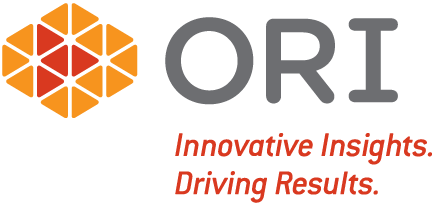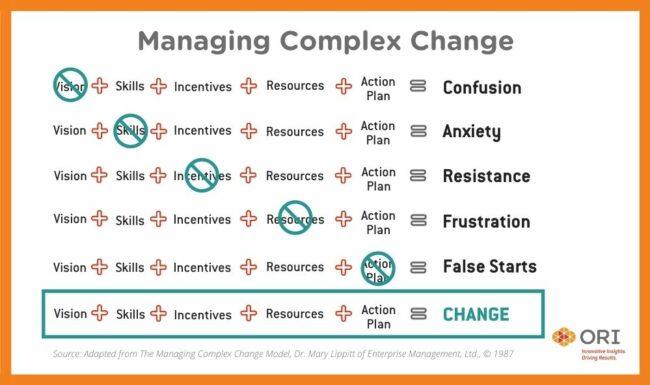Managing Complex Change & the Human Element of Customer Experience
The 5 Essential Ingredients for Successful Change
If the chart above looks familiar, it’s probably because it has made the rounds on social media over the years in various forms. It may look busy but, upon closer inspection, it expertly lays out the 5 most important tools for pushing complex change forward: Vision, Skills, Incentives, Resources, and an Action Plan. Without all of these key ingredients, even the most well-intentioned projects fail to mobilize teams, engage employees, and execute on strategy.
What does this chart have to do with customer experience (CX)? At its core, CX is about relationships. And anyone who has ever introduced new and different approaches to strengthening those external relationships will recognize the key role internal teams play in the success of such efforts. Implementing complex change requires a strong focus on the human element powering that change: your teams.
Every interaction is a customer experience—and your team plays a critical role in these “moments of truth.” Employees at every level have tremendous insight into the customer dynamic—and, similarly, they can make or break the client relationship. It’s always an eye-opening experience to ask teams what they believe are the “moments that matter” for customers and how well the organization is executing during those interactions. Employees often have a finger directly on the pulse of customer needs and know exactly what is causing the most frustration. Empowering your people to take action on customer insights is a critical component in transitioning to a customer-centric culture. It also raises a related issue around your organization’s use of data and how that data is translated into insights for employee use. Chances are your organization is sitting on a mountain of data about your customers’ actions, likes, dislikes, wants, and needs. This information is incredibly valuable, but only if you have someone take the time to thoughtfully analyze your data to glean insights into the customer experience.
So how can the Managing Complex Change Model be of assistance? More than 30 years after it was first developed, this simple formula rings true for guiding modern-day customer experience projects. If you want your teams to embrace a customer-centric culture and persevere through the complex change required, these 5 elements can serve as a helpful checklist:
 Vision—The “why” of the equation, vision is integral to keeping CX initiatives on track and preventing confusion down the road during complex change and project implementation. If everyone involved is not aligned to the direction, confusion will inevitably occur. One way to combat a shaky or weak vision is to approach the project from an outside perspective. Ask yourself, “Is the intent clear and easy to understand?” Better yet, ask a few team members to explain the “why” back to you. It will quickly become clear whether further work is required.
Vision—The “why” of the equation, vision is integral to keeping CX initiatives on track and preventing confusion down the road during complex change and project implementation. If everyone involved is not aligned to the direction, confusion will inevitably occur. One way to combat a shaky or weak vision is to approach the project from an outside perspective. Ask yourself, “Is the intent clear and easy to understand?” Better yet, ask a few team members to explain the “why” back to you. It will quickly become clear whether further work is required.
 Skills—When teams are equipped with the right set of skills for change, anxiety remains low when new challenges arise. Even if a team lacks the right set of skills, having a plan in place to train individuals so they can develop those skills is a good way to combat unease with regard to team performance. Communication and interpersonal skills are the core of many customer experience challenges. Focus here first to determine if the team has been set up for success and, if not, where you can most effectively support their growth.
Skills—When teams are equipped with the right set of skills for change, anxiety remains low when new challenges arise. Even if a team lacks the right set of skills, having a plan in place to train individuals so they can develop those skills is a good way to combat unease with regard to team performance. Communication and interpersonal skills are the core of many customer experience challenges. Focus here first to determine if the team has been set up for success and, if not, where you can most effectively support their growth.
 Incentives—Rewards and incentives encourage movement through complex change. Many assume that incentives are monetary, but that’s not always the case. Think of this instead as “core motivation.” For CX initiatives to truly succeed (and continue to succeed), teams must be bought in to the concept, committed to the value it brings to the organization, and personally motivated by a job well done. Naturally, rewards and recognition play a role in making employees feel proud of their accomplishments and connected to customer outcomes. Real momentum often starts with the internal motivation of a committed core group of employees who see the bigger picture and recognize the win-win relationship inherent in improved customer experience.
Incentives—Rewards and incentives encourage movement through complex change. Many assume that incentives are monetary, but that’s not always the case. Think of this instead as “core motivation.” For CX initiatives to truly succeed (and continue to succeed), teams must be bought in to the concept, committed to the value it brings to the organization, and personally motivated by a job well done. Naturally, rewards and recognition play a role in making employees feel proud of their accomplishments and connected to customer outcomes. Real momentum often starts with the internal motivation of a committed core group of employees who see the bigger picture and recognize the win-win relationship inherent in improved customer experience.
 Resources—Change cannot occur unless the proper resources (like time and tools) are given to those on the project to keep them on the track toward success. If a team is short-staffed or lacks the resources needed to succeed, CX efforts can slowly grind to a halt, resulting in frustration and doubts about the merits of the program. CX, like any organization-wide initiative, demands dedicated resources and plenty of upfront conversations to gain stakeholder buy-in to secure the necessary support. Once you have that organizational influence, keep it by providing regular progress reports to demonstrate the ROI.
Resources—Change cannot occur unless the proper resources (like time and tools) are given to those on the project to keep them on the track toward success. If a team is short-staffed or lacks the resources needed to succeed, CX efforts can slowly grind to a halt, resulting in frustration and doubts about the merits of the program. CX, like any organization-wide initiative, demands dedicated resources and plenty of upfront conversations to gain stakeholder buy-in to secure the necessary support. Once you have that organizational influence, keep it by providing regular progress reports to demonstrate the ROI.
 Action Plan—A shared plan of action will ensure that teams remain aligned with the original vision and resources are used effectively and efficiently. Execution of a well-designed action plan will produce the type of tangible results needed to answer the ever-present question of ROI. Any program or project manager knows it is critical to have a clearly articulated plan with assigned roles and responsibilities tied to deadlines. For those leading a CX program, it’s even more critical to be able to justify the change being requested and overcome the inherent resistance to change by connecting all action steps back to the broader vision.
Action Plan—A shared plan of action will ensure that teams remain aligned with the original vision and resources are used effectively and efficiently. Execution of a well-designed action plan will produce the type of tangible results needed to answer the ever-present question of ROI. Any program or project manager knows it is critical to have a clearly articulated plan with assigned roles and responsibilities tied to deadlines. For those leading a CX program, it’s even more critical to be able to justify the change being requested and overcome the inherent resistance to change by connecting all action steps back to the broader vision.
This chart continues to be popular (and appear in your news feeds) because it outlines a simple but effective way for an organization, team, or project to assess potential problem areas and determine next steps. Time and again, whether we’re coming in fresh or stepping in to redirect a struggling CX project already underway, a client’s biggest hurdle is often developing and implementing a CX strategy. At the onset, priorities must be outlined, buy-in secured, current state measured, and expectations set. CX, like any complex change, will only succeed if you have a clear vision, the necessary skills, motivated employees, vital resources, and a solid action plan. In other words, a robust CX strategy.












